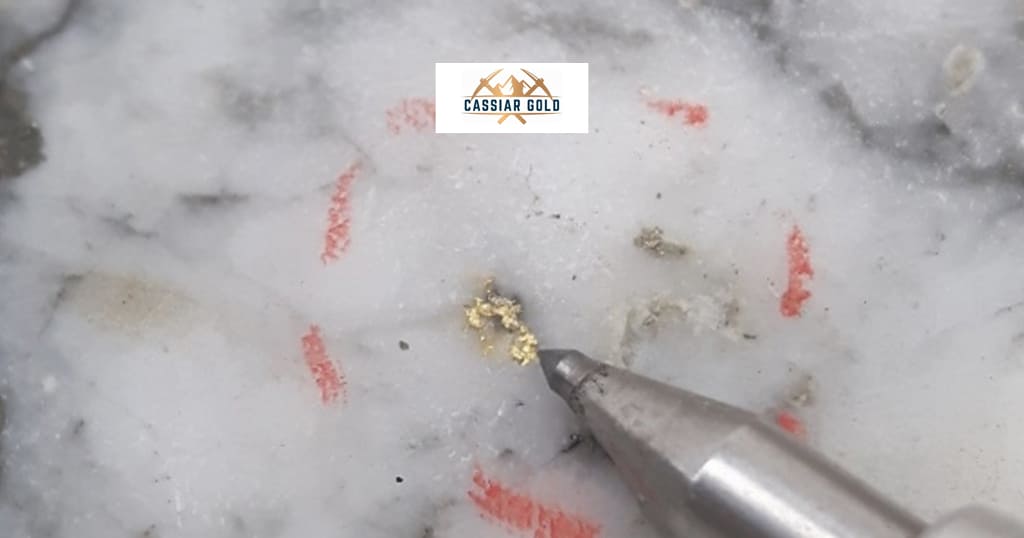Cassiar Gold Corp. announce assay results from an additional seven diamond drill holes from the 2022 exploration program completed at the Bain vein target in the Cassiar South project area within the Company’s flagship Cassiar Gold Property. The results reported here are part of continuing efforts to further explore for extensions of, and for new parallel veins associated with the high-grade, historically producing mines at Cassiar South.
During the 2022 program, Cassiar Gold conducted over 23,000 meters of diamond drilling from 70 drill holes. Exploration was concentrated on strategic areas of the Taurus Deposit in the northern parts of the property, key vein prospects at Cassiar South including Bain vein target areas, and other brownfields targets. Results from 22 drill holes which cumulatively total 7,845 metres of drilling from the 2022 program are yet to be disclosed as the company continues to await the return of additional assay results.
Highlights from the Bain vein target area:
Drill holes reported in this news release are from seven holes totaling 2,380 m from the East Bain Extension and West Bain areas of the past-producing Bain vein system (Figure 1, 4). This drilling was designed to test for lateral and downdip extensions of known mineralization and potential parallel vein sets at the East Bain Extension and West Bain areas, as well as identify potential offset segments of the past-producing vein system at East Bain Extension.
- Drill hole 22EBX-103 intersected multiple mineralized intercepts at the East Bain Extension which include:
- 14.6 m of 2.21 g/t Au, from 159.5 m downhole, including 4.0 m of 5.05 g/t Au, identifying a potential offset continuation of the past-producing Bain vein system 90 m from previous drilling.
- 2.16 m of 32.95 g/t Au from 361.9 m downhole, including 0.55 m of 123.50 g/t Au proximal to the Bain vein, and potentially representing a new parallel vein.
- All holes drilled intersected gold-bearing quartz veins containing anomalous to high-grade gold in the East Bain Extension and West Bain target areas.
- Mineralization encountered at East Bain Extension occurs within an unmined mineralized trend 540 m in strike length below and eastward from existing underground development. Mineralization in this area remains open along strike to the east and downdip.
“We are excited to have expanded gold mineralization at the Bain vein system again in 2022 with these most recent results,” stated Marco Roque, CEO of Cassiar Gold Corp. “This past-producing vein system lies within a permitted mine area with extensions of known mineralization occurring near existing underground infrastructure. Continued success at this part of the property in future exploration campaigns may contribute to identifying low-cost and near-term development opportunities.”
Table 1. Significant 2022 drilling results from the Bain Vein system based on a >0.8 g/t cutoff. While true thickness of some intercepts have not been established, drill holes are designed to cross at high to moderate angles within known corridors of mineralization based on orientations of mineralized areas defined by previous drilling and structural data from oriented drill core.
| Target Area | Drillhole | From | To | Length | Grade | |
| East Bain Extension | 22EBX-1021 | 273.2 | 276.6 | 3.37 m | 0.97 g/t Au | |
| 304.9 | 305.7 | 0.79 m | 7.93 g/t Au | |||
| 22EBX-1032 | 159.5 | 174.1 | 14.64 m | 2.21 g/t Au | ||
| incl. | 160.2 | 168.7 | 8.52 m | 3.22 g/t Au | ||
| incl. | 164.7 | 168.7 | 3.98 m | 5.05 g/t Au | ||
| 361.9 | 364.1 | 2.16 m | 32.95 g/t Au | |||
| incl. | 362.3 | 362.8 | 0.55 m | 123.50 g/t Au | ||
| 22EBX-1042 | 147.9 | 149.5 | 1.59 m | 0.82 g/t Au | ||
| 22EBX-104A2 | 155.5 | 156.4 | 0.94 m | 1.55 g/t Au | ||
| 22EBX-1052 | 234.8 | 235.6 | 0.75 m | 1.09 g/t Au | ||
| 22EBX-1061 | 281.6 | 281.9 | 0.36 m | 14.75 g/t Au | ||
| West Bain | 22WB-2032 | 21.2 | 21.7 | 0.50 m | 1.13 g/t Au | |
| 375.9 | 376.7 | 0.74 m | 1.83 g/t Au | |||
| 1Drill core lengths are reported here. Intercepts for the main Bain vein are 80-95% of true width | ||||||
| 2Drill core lengths are reported here. True widths for these intervals have not been established | ||||||
Cassiar South Project Area
The Cassiar South project area of the Cassiar Gold Property hosts numerous shear vein targets and several past-producing underground mines including the Bain, Cusac, Vollaug and Main Mines, which have historically produced over 315,000 ounces of gold grading between 10 to 20 g/t Au1. The past producing high-grade Vollaug vein is known to have a strike length of up to 3 km.
Veins at Cassiar South are classic, orogenic-style, high-grade gold veins with free gold. They occur in mafic volcanic rocks stacked between low-angle listwanite-bearing thrust surfaces and lenses of fine-grained clastic sediments. Vein sets occur in multiple mafic volcanic units, and there is potential to define: (1) stacked veins below known veins in mafic volcanic units of underlying thrust panels; (2) parallel vein sets beneath overlying sedimentary and listwanite units within thrust panels; (3) extensions of known vein systems.
2022 Drilling at the Bain vein system
The central Bain vein system historically produced 24,000 ounces of gold at an average grade of 13.71 g/t Au from 1993 to 19952. Historical drilling by a previous operator in 1990-91, 2002, 2008 and 2009 in unmined areas demonstrated the eastern continuation of the vein system forming a 2 km long corridor of known high-grade mineralization. The area was subject to additional mine development in 2009 to within 30 m of the unmined East Bain area, allowing for ease of potential future underground access. Drilling from the 2021 exploration program confirmed continuity of the auriferous Bain shear vein structure as a highly prospective exploration corridor for further follow up in 2022.
All seven drill holes reported here successfully intersected significant gold-bearing quartz veins in the east and west Bain areas. These intercepts extended the mineralization corridor of the Bain vein system both down-dip and eastward of the existing underground development.
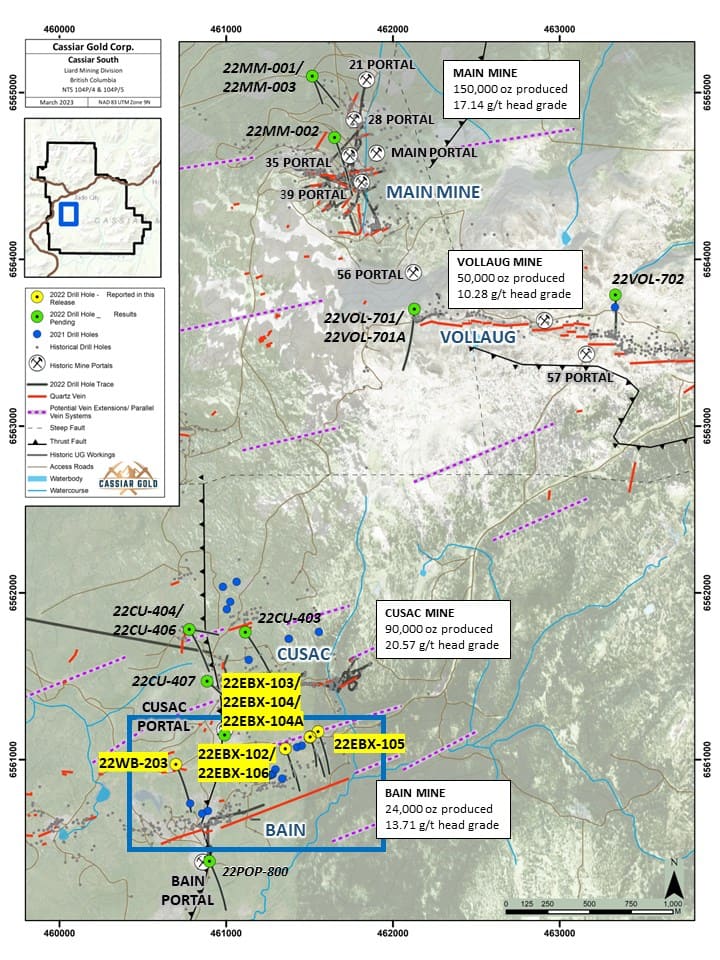
East Bain Extension
Mineralization encountered at East Bain Extension occurs within an unmined mineralized trend greater than 540 m in strike length below and eastward from existing underground development (Figure 2). The Bain system holds potential for continued lateral expansion of mineralization as well as extension of mineralization at depth.

Drill holes 22EBX-103, 22EBX-104/22EBX-104A, 22EBX-105:
These four drill holes (south-southeast oriented) were designed to test for a potential offset segment of the Bain vein system, stepping to the northeast. Late-stage cross cutting, high angle faults commonly offset veins into numerous segments at Cassiar South.
Hole 22EBX-103 encountered a sulphide-mineralized shear quartz vein in carbonate-sericite altered basalt. The vein and host rock exhibited stratigraphic relationships and physical properties coincident with those common to the Bain vein system, as well as a secondary sulphide and gold-mineralized ribboned, stylolitic quartz shear vein at depth. Results (Figure 2, 3, 5; Table 1) include:
- An upper mineralized intercept of 14.6 m of 2.21 g/t Au from 159.5 m downhole, including:
- 8.5 m of 3.22 g/t Au, including 4.0 m of 5.05 g/t Au
- This intercept suggests a northeast continuation of the Bain vein as a potential offset segment or en échelon step of the vein system. These results extend mineralization 90 m northeast of intercepts encountered during the 2021 drill program.
- A lower mineralized intercept of 2.16 m of 32.95 g/t Au from 361.9 m downhole, including:
- 0.6 m of 123.50 g/t Au containing 9 specks of visible gold (Figure 4) and located 120 m east of historical drilling.
- This intercept suggests potential for productive vein sets to occur parallel to the known Bain vein system.
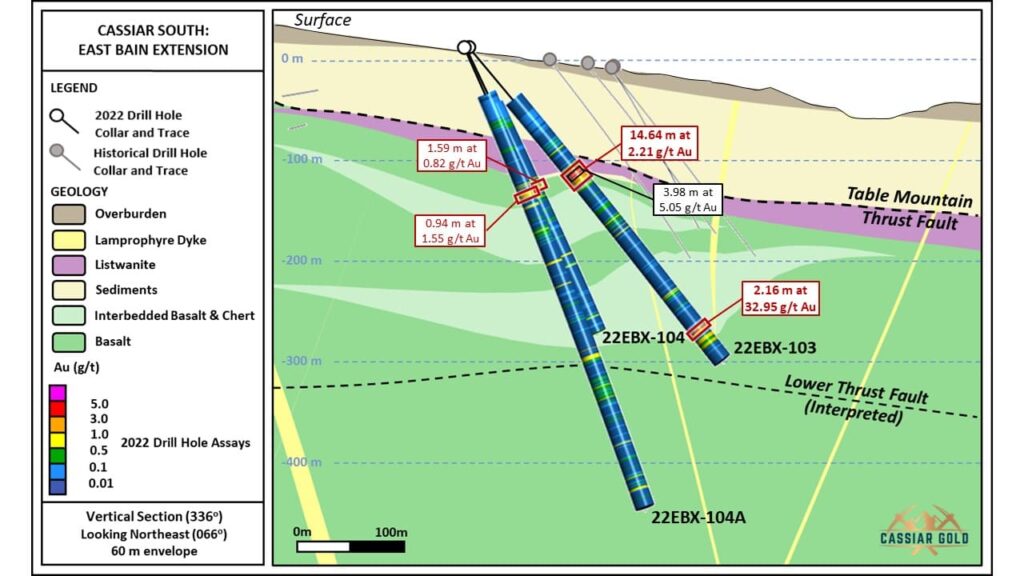
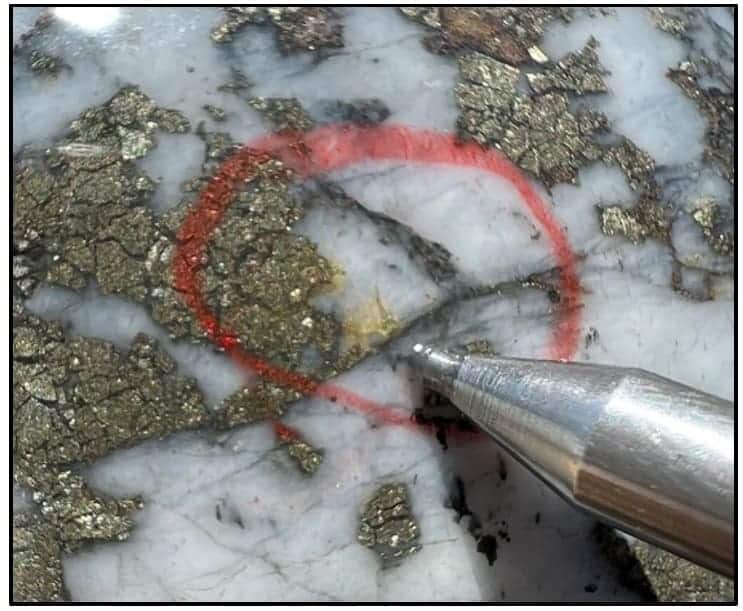
Drill hole 22EBX-104 was designed to test for the down dip extension of veining and mineralization encountered in 22EBX-103. That drill hole was abandoned due to drilling conditions then redrilled to completion as 22EBX-104A. These drill holes identified the northward continuation of the upper mineralized quartz vein intercept in 22EBX-103, returning the following intercepts (Figure 2, 3, 5; Table 1):
- 1.59 m of 0.82 g/t Au from 147.9 m downhole in 22TA-104, and
- 0.94 m of 1.55 g/t Au from 155.5 m downhole in 22TA-104A
Drill hole 22EBX-105 was designed to test for the potential eastward extension of mineralization encountered in 22EBX-103, 45 m along strike to the east. See Figures 2, 4, 5 and Table 1 for results.
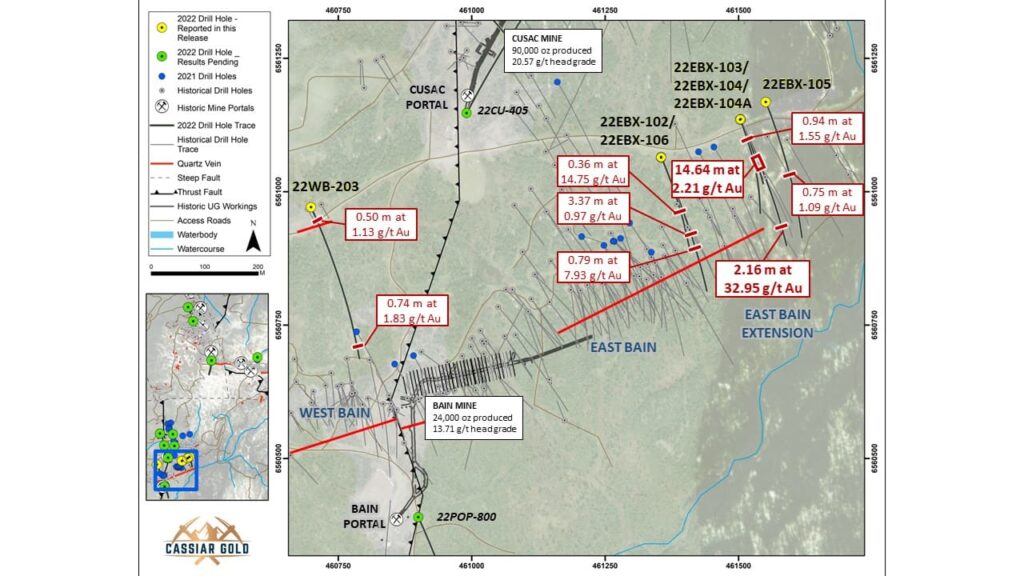
Drill holes 22EBX-102 and 22EBX-106:
Drill hole 22EBX-102 (south southeast-oriented) at East Bain Extension was designed to evaluate the continuity of mineralized quartz veins between the East Bain and the East Bain Extension (Figure 2) target areas, testing 100 m west of drill hole 21EBX-100 from the 2021 drill program and 80 m down dip of historical drilling.
22EBX-106 was designed as an undercut to test for the potential extension of mineralization 65 m down-dip of shear quartz veining encountered in 22EBX-102.
Results include (Figure 2, 5; Table 1):
- 3.37 m of 0.97 g/t Au and 0.79 m of 7.93 g/t Au in 22EBX-102
- 0.36 m of 14.75 g/t Au in 22EBX-106
West Bain
Drill hole 22WB-203
This drill hole was designed to evaluate an under-explored portion of the West Bain target area testing for potential parallel vein sets below a high-grade historical surface trench grab sample, as well as the potential down dip extension of the Bain vein system.
The drill hole encountered (Figure 5, 6; Table 1):
- 2.6 m of intermittent sulphide-mineralized quartz veins from 21.7 m, returning 0.5 m of 1.13 g/t Au with 2 specks of visible gold with minor pyrite noted at 24.0 m, and
- 0.7 m of 1.83 g/t Au from 375.9 m downhole, indicating mineralization at the western extent of the Bain vein system extends 175 m below mineralization encountered in historical drilling.

Mineralization at the Bain vein system remains open down dip and along strike. The 2022 program highlights the potential to identify extensions, new offset segments or en échelon steps of past producing vein systems and new veins parallel to established mineralized corridors.
Qualified Person
The technical information in this news release has been reviewed and approved by Jill Maxwell, P.Geo., Cassiar Gold Corp.’s Exploration Manager, who is a Qualified Person as defined by National Instrument 43-101.
Quality Assurance (QA) and Quality Control (QC)
The 2022 Cassiar drilling program comprises HQ drill core oriented using the REFLEX ACTIII system. Drill core samples are selected and logged by geologists prior to being cut in half using a diamond cutting saw at a secure facility located in Jade City, British Columbia. Certified gold reference standards and blanks are routinely inserted into the sample stream as part of the Company’s QA/QC program. All samples are delivered to the ALS Global preparation facility in Whitehorse, Yukon, where they are processed, and then shipped to the ALS Global analytical facility in North Vancouver, British Columbia. Samples are analyzed for gold by 50-gram fire assay with finish by atomic absorption or gravimetric methods. Screen metallic analysis is performed on selected samples. ALS Global quality systems and technical aspects conform to requirements of ISO/IEC Standard 17025 guidelines.
About Cassiar Gold Corp.
Cassiar Gold Corp. is a Canadian gold exploration company holding a 100% interest in its flagship Cassiar Gold Property located in British Columbia, Canada. The Cassiar Gold property spans 590 km2 and consists of two main project areas: Cassiar North, which hosts a NI 43-101-compliant inferred resource estimate of 1.4Moz at 1.14 g/t Au (cutoff grade of 0.5 g/t Au) known as the as the Taurus Deposit (see National Instrument 43-101 Technical report on the Cassiar Gold property, April 28, 2022, by S. Zelligan, J. Moors, C. Jolette, posted to SEDAR); and Cassiar South which hosts numerous gold showings, historical workings, and exploration prospects. Historical underground mines in the Cassiar South area have yielded over 315,000 oz of Au at average head grades of between 10 and 20 g/t Au (2017, Cowley3), underscoring the high potential for further discovery and expansion of high-grade orogenic gold veins.
The Company also holds a 100% interest in the Sheep Creek gold camp located near Salmo, BC. The Sheep Creek gold district ranks as the third largest past-producing orogenic gold district in BC with historical gold production of 742,000 ounces gold at an average grade of 14.7 g/t gold from 1900 to 1951. Minimal exploration work has been conducted since the 1950s.
Cassiar Gold Corp. acknowledges, respects, and supports the rights of Traditional First Nations in the lands and communities where we operate.
CONTACT INFORMATION
Cassiar Gold Corp.
E-mail: [email protected]
Phone: 236-878-6160
1 See April 28, 2022, NI43-101 Report titled “National Instrument 43-101 Technical Report on the Cassiar Gold Property” by Zelligan, P.Geo, Moors, P.Geo, Jolette, P.Geo.
2 See April 28, 2022, NI43-101 Report titled “National Instrument 43-101 Technical Report on the Cassiar Gold Property” by Zelligan, P.Geo, Moors, P.Geo, Jolette, P.Geo.
3Cowley, 2017, NI43101 Technical Report on the Cassiar Gold Property, British Columbia, for China Minerals Mining Corp, June 26, 2017, revised Oct 2, 2017










